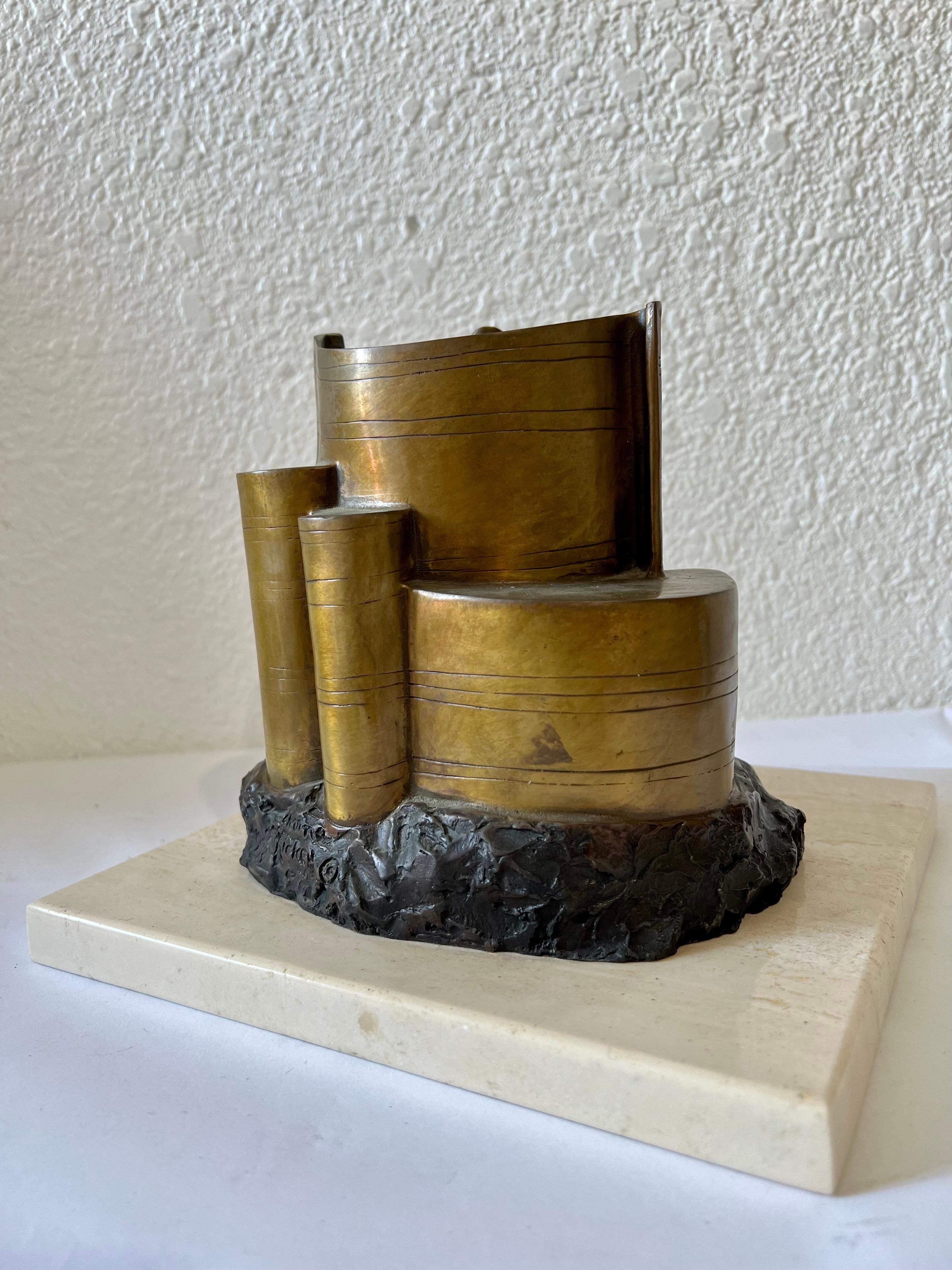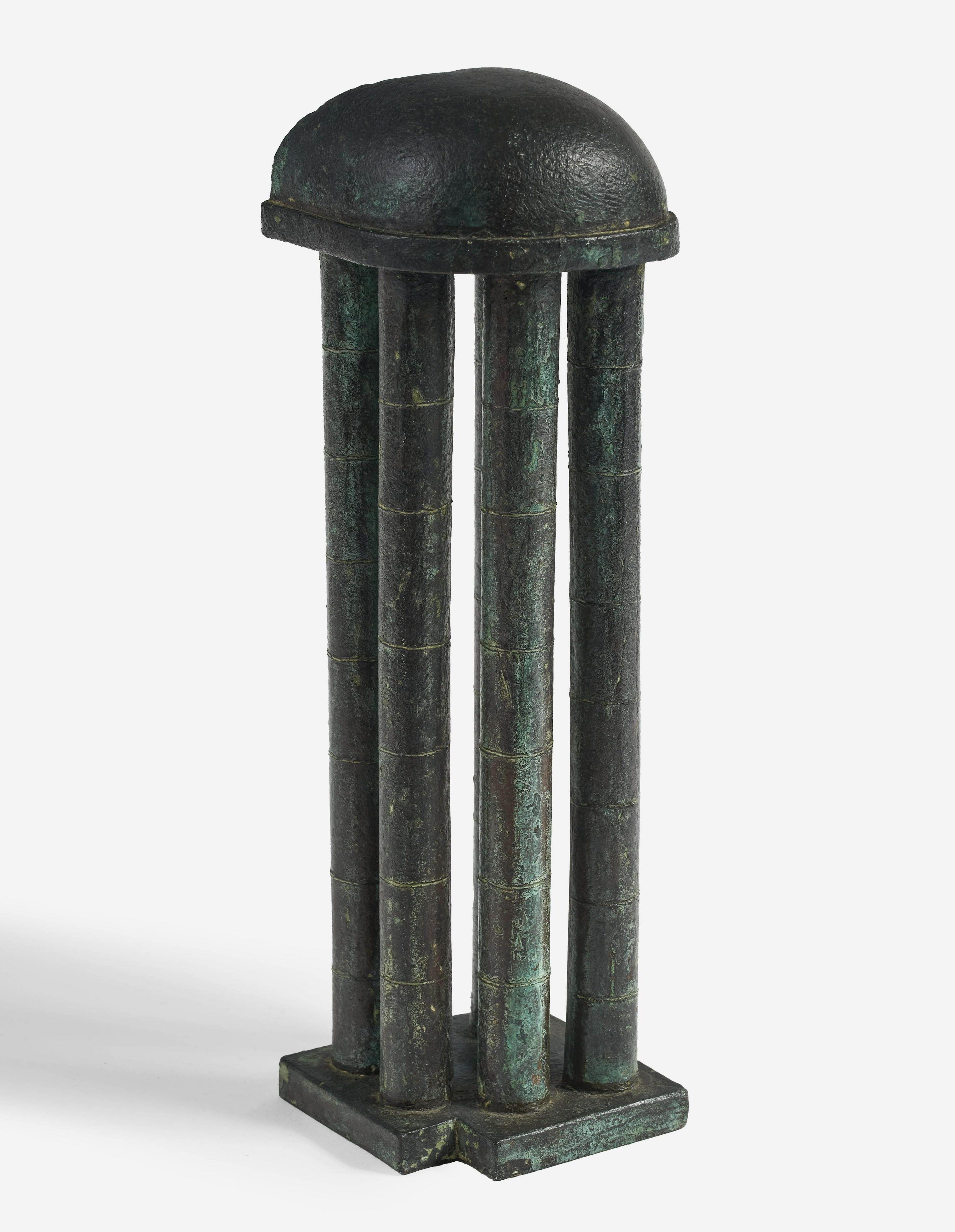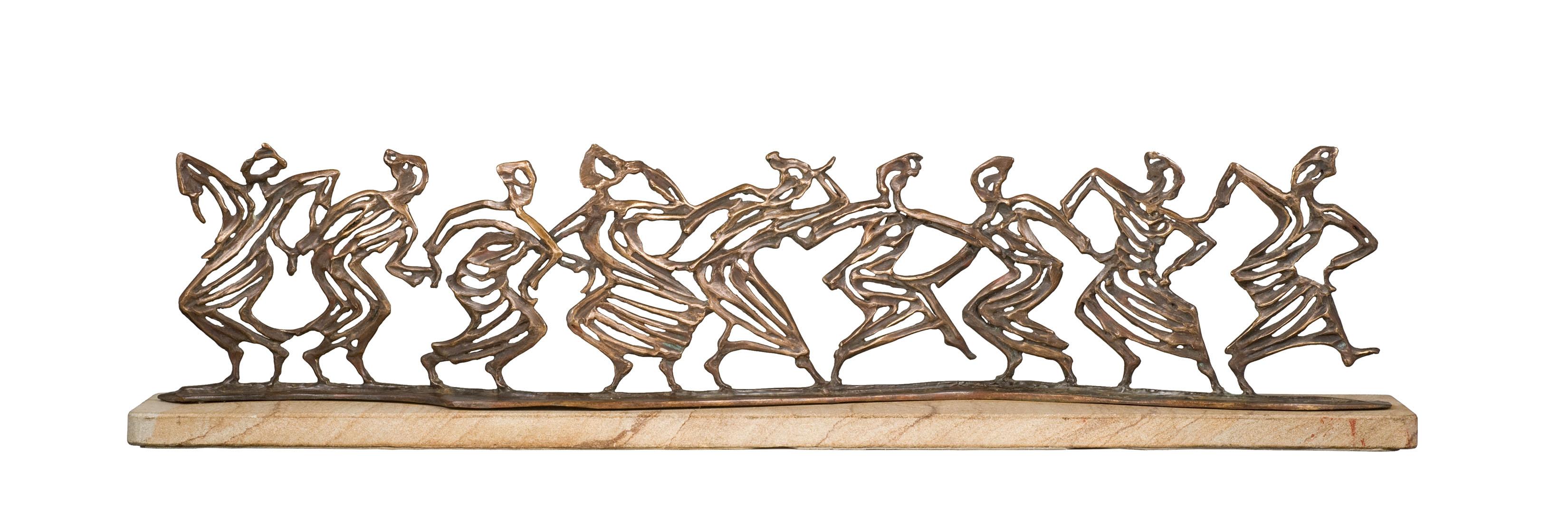Items Similar to Eugene Caples "Bronze Sculpture II" Abstract Bronze Sculpture
Want more images or videos?
Request additional images or videos from the seller
1 of 5
Eugene CaplesEugene Caples "Bronze Sculpture II" Abstract Bronze Sculpture1985 - 1995
1985 - 1995
About the Item
SALE ONE WEEK ONLY
This small exquisite "Bronze Sculpture II" is in excellent condition and a perfect example of Eugene Caples craftsmanship. This is mainly abstract with some graphic or architectural elements and is so delightful that mythical creatures demand to be considered. It cries out to be touched and held, looked at and caressed. The beautiful patina on the surface gives voice to the many hands that have done these things.
Eugene Caples is a designer and craftsman who worked in Kansas City in the 1960s and later through the early 21st century. He attended the Kansas City Art Institute, earning his Bachelors of Fine Arts in Industrial Design in 1959. In 1963 he was accepted to Cranbrook Academy of Art, Bloomfield Hills, Michigan. The Cranbrook Academy of Art was designed by architect and faculty member, Eliel Saarinen who collaborated with Charles and Ray Eames on chair and furniture design. Numerous creative artists are alumni of Cranbrook and include: Harry Bertoia, Florence Knoll, Jack Lenor Larsen, Donald Lipski, Duane Hanson, Nick Cave, Hani Rashid, George Nelson, Urban Jupena (Nationally recognized fiber artist), Artis Lane (the first African-American artist to have her sculpture, "Sojourner Truth," commissioned for the Emancipation Hall in the Capital Visitor Center in Washington DC), Cory Puhlman (televised Pastry Chef extraordinaire), Thom O’Connor (Lithographs), and Paul Evans (Created Brutalist-inspired sculpted metal furnishings.)
Gene worked primarily with cast, cut and welded bronze in Brutalist abstract designs, experimenting with iron and aluminum as well. His furniture designs from the 1960s were primarily forms of cabinetry on wire rod bases.
- Creator:
- Creation Year:1985 - 1995
- Dimensions:Height: 4.75 in (12.07 cm)Width: 4 in (10.16 cm)
- Medium:
- Movement & Style:
- Period:
- Condition:
- Gallery Location:Detroit, MI
- Reference Number:1stDibs: LU128615259272
About the Seller
5.0
Vetted Seller
These experienced sellers undergo a comprehensive evaluation by our team of in-house experts.
Established in 2014
1stDibs seller since 2019
95 sales on 1stDibs
Typical response time: 4 hours
- ShippingRetrieving quote...Ships From: Detroit, MI
- Return PolicyA return for this item may be initiated within 14 days of delivery.
More From This SellerView All
- Eugene Caples "Bronze Sculpture I" Abstract Bronze SculptureBy Eugene CaplesLocated in Detroit, MISALE ONE WEEK ONLY This small exquisite "Bronze Sculpture I" is in excellent condition and a perfect example of Eugene Caples craftsmanship. Although it is mainly abstract, there are bits that look figurative either an arm or a leg attempting to emerge from a fold or attempting to hold a pose such as in yoga. It cries out to be touched and held, looked at and caressed. The beautiful patina on the surface gives voice to the many hands that have done these things. Eugene Caples is a designer and craftsman who worked in Kansas City in the 1960s and later through the early 21st century. He attended the Kansas City Art Institute, earning his Bachelors of Fine Arts in Industrial Design in 1959. In 1963 he was accepted to Cranbrook Academy of Art, Bloomfield Hills, Michigan. The Cranbrook Academy of Art was designed by architect and faculty member, Eliel Saarinen who collaborated with Charles and Ray Eames on chair and furniture design. Numerous creative artists are alumni of Cranbrook and include: Harry Bertoia, Florence Knoll, Jack Lenor Larsen, Donald Lipski, Duane Hanson, Nick Cave, Hani Rashid, George Nelson, Urban Jupena (Nationally recognized fiber artist), Artis Lane (the first African-American artist to have her sculpture, "Sojourner Truth," commissioned for the Emancipation Hall in the Capital Visitor Center in Washington DC), Cory Puhlman (televised Pastry Chef extraordinaire), Thom O’Connor (Lithographs), and Paul Evans (Created Brutalist-inspired sculpted metal furnishings.) Gene worked...Category
Late 20th Century American Modern Abstract Sculptures
MaterialsBronze
- John Glick Plum Street Pottery Glazed Bowl Reduction FiredLocated in Detroit, MI"Untitled" is a stoneware piece with the decorative layer of the rich toned glazes and markings that John was so well-known for. Each piece that John produced was unique. The lip on this piece is slightly scalloped and the shape is removed from the boring circular to mimic a gentle geometric design. He was seduced by the effects of the reduction kiln, which decreased the levels of oxygen during firing, inducing the flame to pull oxygen out of the clay and glazes changing the colors of the glazes depending on their iron and copper content. In this way he achieved the rich gradients of ochre and umber and variations in stippling and opacity. This piece is signed and stamped on the bottom. John was an American Abstract Expressionist ceramicist born in Detroit, MI. Though open to artistic experimentation, Glick was most influenced by the styles and aesthetics of Asian pottery—an inspiration that shows in his use of decorative patterns and glaze choices. He has said that he is attracted to simplicity, as well as complexity: my work continually reflects my re-examination that these two poles can coexist… or not, in a given series. Glick also took influences from master potters of Japan, notably Shoji Hamada and Kanjrio Kawai, blending their gestural embellishments of simple forms with attitudes of Abstract Expressionism. He was particularly drown to the work of Helen Frankenthaler whose soak-stain style resonated with Glick’s multi-layered glaze surfaces, which juxtaposed veils of atmospheric color with gestural marks and pattern. He spent countless hours developing and making his own tools in order to achieve previously unseen results in his work with clay and glaze. Glick’s “Plum Tree Pottery...Category
1970s American Modern Abstract Sculptures
MaterialsStoneware, Glaze
- Magnificent John Glick Plum Street Pottery "Scalloped Box" Glazed StonewareLocated in Detroit, MIThis magnificent "Scalloped Box" is a stoneware piece with decorative layers of rich toned glazes and markings that John was so well-known for. He was, also, known for the undulating lip lines on his exquisite boxes that fit together like a puzzle. Each piece that John produced was unique. He was seduced by the effects of the reduction kiln, which decreased the levels of oxygen during firing, inducing the flame to pull oxygen out of the clay and glazes thereby changing the colors of the glazes depending on their iron and copper content. In this way he achieved the rich gradients of ochre and umber and variations in stippling and opacity. This piece is signed and stamped on the bottom. John was an American Abstract Expressionist ceramicist born in Detroit, MI. Though open to artistic experimentation, Glick was most influenced by the styles and aesthetics of Asian pottery—an inspiration that shows in his use of decorative patterns and glaze choices. He has said that he is attracted to simplicity, as well as complexity: my work continually reflects my re-examination that these two poles can coexist… or not, in a given series. Glick also took influences from master potters of Japan, notably Shoji Hamada and Kanjrio Kawai, blending their gestural embellishments of simple forms with attitudes of Abstract Expressionism. He was particularly drown to the work of Helen Frankenthaler whose soak-stain style resonated with Glick’s multi-layered glaze surfaces, which juxtaposed veils of atmospheric color with gestural marks and pattern. He spent countless hours developing and making his own tools in order to achieve previously unseen results in his work with clay and glaze. Glick’s “Plum Tree Pottery...Category
Late 20th Century American Modern Abstract Sculptures
MaterialsStoneware, Glaze
- Breathtaking John Glick "Scalloped Basket" Glazed Stoneware Reduction FiredLocated in Detroit, MI"Scalloped Basket" is a stoneware piece with the decorative layer of the rich toned glazes and markings that John was so well-known for. He was, also, known for the undulating lip lines on his exquisite pieces. The basket portion is shaped with gentle curves and a sculptural handle. Each piece that John produced was unique. He was seduced by the effects of the reduction kiln, which decreased the levels of oxygen during firing, inducing the flame to pull oxygen out of the clay and glazes changing the colors of the glazes depending on their iron and copper content. In this way he achieved the rich gradients of ochre and umber and variations in stippling and opacity. This particular "basket" also has the cool blues and grays that contrast with the umber. It is signed and stamped on the bottom. John was an American Abstract Expressionist ceramicist born in Detroit, MI. Though open to artistic experimentation, Glick was most influenced by the styles and aesthetics of Asian pottery—an inspiration that shows in his use of decorative patterns and glaze choices. He has said that he is attracted to simplicity, as well as complexity: my work continually reflects my re-examination that these two poles can coexist… or not, in a given series. Glick also took influences from master potters of Japan, notably Shoji Hamada and Kanjrio Kawai, blending their gestural embellishments of simple forms with attitudes of Abstract Expressionism. He was particularly drown to the work of Helen Frankenthaler whose soak-stain style resonated with Glick’s multi-layered glaze surfaces, which juxtaposed veils of atmospheric color with gestural marks and pattern. He spent countless hours developing and making his own tools in order to achieve previously unseen results in his work with clay and glaze. Glick’s “Plum Tree Pottery...Category
1970s American Modern Abstract Sculptures
MaterialsStoneware, Glaze
- Glen Michaels "Winter Wind", Pentaptych Mosaic StoneLocated in Detroit, MISALE ONE WEEK ONLY This American Modern mosaic abstract sculpture has an extraordinary flow and liquid movement that belies its creation in stone. Its color is in keeping with the title, Winter Wind, a cold gray with sparks of orange and golden sepia. Michaels passed away in 2020 and was remembered by Cranbrook Art Museum: “Michaels is featured in the upcoming book, With Eyes Opened: Cranbrook Academy of Art Since 1932 (available in 2021) and will have work featured in the accompanying exhibition opening at Cranbrook Art Museum in June 2021. Below is an excerpt from the book, written by Eva Caston. “Glen Michaels was initially inclined towards a career in music. He played piano for vaudeville shows and won a scholarship to the Yale School of Music in 1950. There he drew caricatures for the school newspaper, painted portraits, and published a book of cartoons entitled Oh, You’re a Musician, which caught the attention of New Yorker cartoonists Mary Petty and Alan Dunn. He went on to receive his BA in arts education from Eastern Washington University in 1957. His teachers at Eastern Washington, Opal Fleckenstein and Frank...Category
1970s American Modern Abstract Sculptures
MaterialsStone
- "Draped Figure" Sassafras & Bronze, Figurative Sculpture, 1982Located in Detroit, MI"Draped Figure" is a beautiful example of Tazian's ability to meld the smooth texture of wood and the hard texture of bronze into an exquisite object to view, hold or caress. The piece balances perfectly on its stone base and can be easily turned to enjoy from all angles. Like architects Eliel Saarinan and Albert Kahn and sculptor Corrado Parducci, Tazian is an immigrant creative who has found a home in the city, nurtured by its energy and sheltered by its community. He developed an early ambition to become an artist, even though he had very little exposure to the arts. ““The only person [who encouraged me] was my 5th grade English teacher, Olivia Balian,” he says. “She really opened the doors of art for me. She said, ‘Those students who are interested in art can stay behind after school and I will show you how to paint and draw.’ Somehow [that] changed my life– she gave me that spark.” Tazian came to the U.S. to study at St. Francis College in Fort Wayne, Indiana. He earned a bachelor’s degree in art and a Master’s in Art Education, and then earned and MFA in sculpture from Wayne State University in Detroit. Kegham Tazian is an award-winning sculptor and painter. The Armenian-born artist has gained notoriety for the diversity of his work and the variety of media exemplified in his pieces. A blend of modernism, realism and abstraction are commonly depicted in his paintings and sculptures. His artwork has been represented in more than 40 solo exhibitions and more than 75 group exhibitions throughout the United States, Canada, Europe, and the Middle East. His work adorns the entrances and halls of major corporations, universities and municipalities, including Siemens Corporation, Huntington Bank, Wayne State University and the city halls of Farmington and Farmington Hills...Category
21st Century and Contemporary Modern Abstract Sculptures
MaterialsStone, Bronze
You May Also Like
- Bronze Abstract Space Age Book Sculpture LA California Modernist Charna RickeyBy Charna RickeyLocated in Surfside, FLCharna Rickey 1923 - 2000 Mexican-American Jewish Woman artist. Signed Bronze House of Books, Architecture Bronze sculpture, signed Charna Rickey and on the front "House of the book." It depicts an open Torah. Original patina. Approx. dimensions: 7 in. H x 9 in. W x 8.5 in. D. Weight: 13.1 lbs. Modernist Judaica Sculpture Born Charna Barsky (Charna Ysabel or Isabel Rickey Barsky) in Chihuahua, Mexico, the future artist lived in Hermosillo and immigrated to Los Angeles when she was 11. She was educated at UCLA and Cal State L.A., she married furniture retailer David Rickey and explored art while raising their three daughters. Moving through phases in terra cotta, bronze, marble and aluminum, she found success later in life. Rickey became one of the original art teachers at Everywoman's Village, a pioneering learning center for women established by three housewives in Van Nuys in 1963. She also taught sculpture at the University of Judaism from 1965 to 1981. As Rickey became more successful, her sculptures were exhibited in such venues as Artspace Gallery in Woodland Hills and the Courtyard of Century Plaza Towers as part of a 1989 Sculpture Walk produced by the Los Angeles Arts Council. Her sculptures have also found their way into the private collections of such celebrities as Sharon Stone. Another of Rickey's international creations originally stood at Santa Monica College. In 1985, her 12-foot-high musical sculpture shaped like the Hebrew letter "shin" was moved to the Rubin Academy of Music and Dance at Hebrew University in Jerusalem. The free standing architectural Judaic aluminum work has strings that vibrate in the wind to produce sounds. Rickey also created art pieces for the city of Brea. They commissioned some amazing art pieces by Laddie John Dill, Walter Dusenbery, Woods Davy, Rod Kagan, Pol Bury, Niki de Saint Phalle, Magdalena Abakanowicz, Larry Bell, John Okulick...Category
20th Century American Modern Abstract Sculptures
MaterialsMarble, Bronze
- Bronze Architectural Model Sculpture Tempio Bretton Architecture MaquetteLocated in Surfside, FLTEMPIO BRETTON: from the catalogue MONUMENTA, 19th International Sculpture Biennale, Antwerp, Belgium. Tempio Bretton was created in homage to the celebrated English landscapist Capability Brown for the occasion of an exhibition at Bretton Hall in the Yorkshire Sculpture Park , a park in the style of the great master of English garden design. The inclusion in the English garden of a temple ruin, or "eye-catcher," (architectural folly) was used to draw the eye and mind to a focus in time and space, present the beholder with an immediate relationship to an historic past made new within his or her own surroundings, and create a depth of space never before seen in garden design. I took the idea of the temple ruin eye-catcher and reduced it to a scale at the point where architecture and sculpture merged. Tempio Bretton is not capacious enough to walk into, yet it is considerably larger than a man. One view of it presents a knot of golden columns clustered together, topped by a dome shape. The only clue from this side to the temple's non-conformity to historic principle is a sharp notch cut into the square base. Viewed from the opposite side, the cluster of columns capped by an angular top opens up as if to welcome someone in, yet the mysterious core is still impenetrable. These contradictions articulate a confrontation between past and present, and an exciting truth. The past is always at the heart of our constructions in the present. Walter Dusenbery...Category
20th Century American Modern Abstract Sculptures
MaterialsBronze
- Virasat Curved, figurative bronze mantle pieceBy Robert CookLocated in Greenwich, CTA remarkable and unique format bronze of unique cast that could be great for a mantle or console table. In Robert Cook's book entitled “Waxing and Waning” he discusses three castings...Category
Early 2000s American Modern Abstract Sculptures
MaterialsStone, Bronze
- Giraffe Gates, bronze sculptureBy Robert CookLocated in Greenwich, CTThis unique cast bronze is the perfect work to silhouette in front of a plain wall area. It acts as a line drawing in space. Robert Cook explored the limits of the lost was casting ...Category
1980s American Modern Abstract Sculptures
MaterialsBronze
- Black Falling Man with FormBy Ernest Tino TrovaLocated in Missouri, MOErnest Tino Trova "Black Falling Man with Form" 1996 Bronze Ed. 1/3 Signed, Dated and Numbered Verso approx. 16 x 8.5 x 16 inches Known for his Falling Man series in abstract figura...Category
1990s American Modern Figurative Sculptures
MaterialsBronze
- Vivid HarmonyBy Brad RudeLocated in Denver, COArtist Brad Rude was born in Montana and has lived in Walla Walla, Washington most of his life. His journeys through his grandfather's folk art studio left...Category
2010s American Modern Abstract Sculptures
MaterialsBronze, Enamel
Recently Viewed
View AllMore Ways To Browse
Vintage Bronze
Gold Bronze Sculptures
Bronze Well
Modern Bronze Sculpture
Modern Bronze Sculptures
Gold Modern Sculpture
Fine Art Bronze
Small Modern Sculpture
Small Modern Sculptures
Sculpture Fine Bronze
Bronze Sculpture Of A Hand
Beautiful Bronze Sculpture
Bronzed Metal Sculpture
Sculpture Chairs
Small Bronze Sculpture
Small Gold Sculpture
Modern Abstract Bronze
Metal Modern Abstract Sculpture





